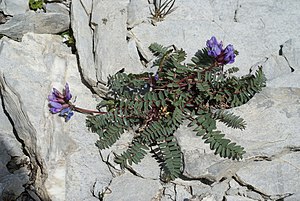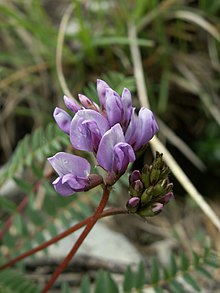Pointed mountain keel
| Pointed mountain keel | ||||||||||||
|---|---|---|---|---|---|---|---|---|---|---|---|---|

Pointed keel ( Oxytropis jacquinii ) |
||||||||||||
| Systematics | ||||||||||||
|
||||||||||||
| Scientific name | ||||||||||||
| Oxytropis montana | ||||||||||||
| ( L. ) DC. |
The mountain pointed keel ( Oxytropis montana ), also known as mountain vetch , is a species of the genus pointed keel ( Oxytropis ) in the subfamily of the butterflies (Faboideae).
description
Vegetative characteristics
The pointed keel grows as a perennial herbaceous plant and usually reaches heights of 5 to 20 centimeters. The above-ground parts of the plant are hairy. The very short stem is prostrate to ascending and often spread out in a grassy manner (it is loosely hairy and hairy to bald); or no stems are visible.
The rosette to alternate leaves are divided into a petiole and a leaf blade. The petiole is reddish. The imparipinnate leaf blade has 8 to 17, rarely up to 20 pairs of leaflets. The leaflets are ovate-lanceolate to lanceolate. Both sides of the leaflets are silky and hairy and later bald. The stipules are fused at most at their base.
Generative characteristics
The flowering period extends from June to August. The relatively long inflorescence stem is about as long as the leaves. Five to fifteen, rarely up to twenty flowers are arranged upright in a racemose , cephalic inflorescence . The bracts hardly reach to the middle of the calyx tube.
The hermaphrodite flower is zygomorphic with a length of 10 to 13 millimeters and five-fold with a double flower envelope . The five sepals are fused and the calyx teeth are up to 1/3 as long as the calyx tube. The crown is red to blue-violet, purple to purple. The hairy to balding boat has a clear point (hence the name pointed keel and Oxytropis = "pointed keel" and a clear difference to the genus Astragalus ).
The upright or protruding legume , stalked in the calyx, is 2 to 3 centimeters long, puffed up, furrowed and bald.
The number of chromosomes is 2n = 16.
Occurrence
The pointed keel occurs in Germany , Austria , Switzerland , France and Italy . The Berg-Spitzkiel thrives mainly in the limestone chains of the Eastern Alps and westwards to Savoy . It usually thrives on rocks, rock debris, grasslands on limestone and dolomite . The Berg-Spitzkiel can be found at altitudes of 1500 to 3000 meters. In the Allgäu Alps, it rises to an altitude of over 2000 meters. It is a character type of the Seslerion association and also occurs in the Elynetum.
Taxonomy
In 2009 Guterman gave the name to Oxytropis montana (L.) DC. set. Before that, from 1961 Oxytropis jacquinii Bunge , published by Alexander von Bunge in works of the Natural Research Association of Riga , 1, 1847 page 226, was the accepted name. The first publication took place in 1753 under the name ( Basionym ) Astragalus montanus L. by Carl von Linné in Species Plantarum , 2, page 760. The new combination to Oxytropis montana (L.) DC. was published by Augustine Pyramus de Candolle in Astragalogia , 66, (ed. quarto), no. 1. 1802. Other synonyms for Oxytropis montana (L.) DC. are: Astragalus jacquini (Bunge) AWHill , Astragalus montanus var. jacquini (Bunge) P.Fourn. , Phaca montana (L.) All. , Spiesia montana (DC.) Kuntze , Oxytropis montana subsp. jacquini (Bunge) Nyman , Oxytropis montana subsp. jacquinii (Bunge) Brown-Blanq .
literature
- Xaver Finkenzeller, Jürke Grau: Alpine flowers. Recognize and determine (= Steinbach's natural guide ). Mosaik, Munich 2002, ISBN 3-576-11482-3 .
- Manfred A. Fischer, Wolfgang Adler, Karl Oswald: Excursion flora for Austria, Liechtenstein and South Tyrol . 2nd, improved and enlarged edition. State of Upper Austria, Biology Center of the Upper Austrian State Museums, Linz 2005, ISBN 3-85474-140-5 .
Individual evidence
- ↑ a b c d e f g h Oxytropis montana (L.) DC., Berg-Spitzkiel. In: FloraWeb.de.
- ↑ a b c d e f g h i j Oxytropis jacquinii Bunge In: Info Flora , the national data and information center for Swiss flora . Retrieved October 22, 2018.
- ↑ a b Erich Oberdorfer : Plant-sociological excursion flora for Germany and neighboring areas. 8th edition. Verlag Eugen Ulmer, Stuttgart 2001, ISBN 3-8001-3131-5 . Page 603–604.
- ↑ Erhard Dörr, Wolfgang Lippert : Flora of the Allgäu and its surroundings. Volume 2, IHW, Eching 2004, ISBN 3-930167-61-1 , p. 144.
- ↑ a b Walter Guterman: Notulae nomenclaturales 29-40 (the nomenclature of vascular plants in Austria). In: - Phyton (Horn) , Volume 49, 2009, pp. 77-92.
- ^ W. Gutermann, H. Merxmüller: The European clans of Oxytropis Sectio Oxytropis . In: Mitteilungen der Botanische Staatssammlung München , Volume 4, 1961, pp. 199–276. Here pp. 231-233.
- ↑ Oxytropis jacquinii Bunge at Tropicos.org. Missouri Botanical Garden, St. Louis, accessed October 22, 2018.
- ↑ Oxytropis montana (L.) DC. at Tropicos.org. Missouri Botanical Garden, St. Louis, accessed October 22, 2018.
- ^ Arto Kurtto: Atlas Florae Europaeae, 19 - Leguminosae (Fabaceae) (Astragalus to Erophaca) - "Draft text", June 2017, PDF. - Oxytropis montana (L.) DC. on p. 78.
Web links
- Pointed mountain keel . In: BiolFlor, the database of biological-ecological characteristics of the flora of Germany.
- Profile and distribution map for Bavaria . In: Botanical Information Hub of Bavaria .
- Thomas Meyer: Data sheet with identification key and photos at Flora-de: Flora von Deutschland (old name of the website: Flowers in Swabia ).
- Data sheet distributed in France by Tela Botanica .
- Günther Blaich: data sheet with photos.
- Gerhard Nitter: Profile with photos.
- Fabaceae / Oxytropis montana s. st. - Austria-Spitzkiel / Jacquin-Sp. / Mountain Sp. / "Mountain Sp." - Data sheet with photos at Botanik im Bild / Flora of Austria, Liechtenstein and South Tyrol, last edited on October 29, 2011.



